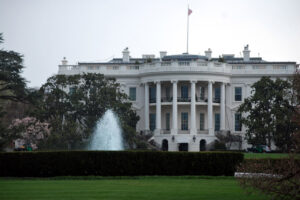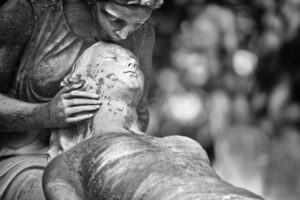
This Dharma Byte follows on last month’s, titled “An Act of Pure Evil,” quoted from the current POTUS. He was referring to the Las Vegas shooting, which held our attention for about a month. This time, he moderated his comment to “An Act of Evil.” Perhaps the difference between the two events is in the numbers killed, one of many measurables with which he seems to be obsessed, along with the press.
The title is intentionally phrased as a headline you might encounter in the news. As such, it is designed to catch your attention, and to encapsulate the message in as few words as possible. As a headline, it does not have to be true, nor even represent the beliefs of the writer. It just has to cut through the clutter.
One of my habits, which may turn out to be good or bad depending on the day, is to quickly check the latest tragicomic event in the news as I arise each morning. This particular day followed the latest church shootings that took enough lives to get the 24/7 attention of the media, especially the death of the 14-year old daughter of the pastor and his wife, who happened to be away from church that morning. When I hit the remote, a reporter was conducting an on-the-street interview with a member of the congregation, who was saying about the preacher, “He was just…a man of God” if I heard her correctly. The reporter mentioned that the daughter had been killed in their absence, and then asked, while a fuzzy image of a young girl appeared on the screen, “How did they take the news?”
Responding to the intolerably insensitive nature of that question, I immediately hit the off button, and decided to write this piece. My major point is not the wretched state of the news profession, but I believe it provides an appropriate backdrop, a contextual aside, for illustrating one of the many kinds of ignorance that we find cloaked in the cultural memes of today. This reporter is making a substantial living, doing what he does, we may presume, simply because he is on camera. And the organization he works for must think that he is doing a good job, or they would not have his face fronting their program.
That he casually asks such an incredibly rude question — to which we all already know the answer, or really, in all decency, do not need to know — apparently only to wring more blood from the story, seems to capture the character of the new norm of professional reportage. That the photo of the hapless victim is out-of-focus may represent a nod to decency, or perhaps is the only way to skirt around the prohibition against showing victims without permission. In any case, this vulture-like savaging of carnage for profit is detestable, but, again, not the main point I wish to make. Others would argue that he is just doing his job, after all.
The title of this piece implies the classical Buddhist theory of rebirth, which, as I understand it, holds that death leads to rebirth, in almost all cases. Without going into the esoteric dimensions, or the differences between rebirth and reincarnation, the prevalent meme of Buddha’s time, I simply want to present it, rebirth, as perhaps the single doctrine, in Buddhism, that comes closest to a religious belief. Scientifically, it is safe to say, we have little or no evidence that rebirth can be proven, other than the testimony of Buddha himself, according to the story; or that of Tibetan monastics, who famously claim to be able to recognize reincarnated lamas. But it makes as much sense as any of the other beliefs now extant, about life and death, and in particular, life after death. The many teachings on the Zen approach to this issue make it clear that rebirth, unlike reincarnation, is not technically a belief. We may regard it as a plausible alternative to the other beliefs around this fraught subject.
In the design business — because we are engaged in problem-solving activities on behalf of clients for money, or on behalf of ourselves for our own sanity, or both — we often engage in a process called, simply, “What if?” What if we did it this way; what if we redefined the problem to be this instead; what if we ordered in some sandwiches instead of breaking for lunch?
In the case of much of the doctrinal teachings of Buddhism, this what if? approach may be the most reasonable for considering their validity, for getting at their implications, and for deciding whether or not we want to accept or reject them. One great line of many in the ancient Chinese poem, “Trust in Mind” (J. Hsinhsinming), says, “To move in the One Way, do not reject even the world of senses and ideas; indeed to accept them fully is identical with true enlightenment.” (from the Liturgy of the Soto Zen Sect).
The conventional understanding is that Zen is, if not anti-intellectual, certainly not intellectual. That is, its wisdom and insight do not depend upon an intellectual understanding of life. Indeed, Zen calls upon us to go beyond the discriminations of the thinking mind, if not to reject them outright. The same poem, elsewhere, says, “Here, thought, feeling, knowledge and imagination are of no value.” Here being in the warm embrace of ultimate insight. Our treasured talents for thinking, emoting, knowing, and imagining are all found equally lacking, totally beggared, in the face of that which cannot be thought, felt, known, or even imagined, in the ordinary sense.
This seeming contradiction is resolved, I think, in our acting out of the teaching in our daily lives. While we are not to reject the world of senses and ideas, we are also not to attempt to depend upon this great capacity for creativity, at least when it comes to our efforts to come into harmony with the Great Way. These usual tricks of the discriminating mind simply won’t work. But nonetheless, the conceptual faculty of mind is not, in itself, a barrier to insight. It can help us to sort through the many and various kinds of delusion, for example.
So what if we apply this What if? approach to the notion of rebirth? We might simply ask ourselves, What if it is true? What if, in the great majority of cases, death, no matter how it comes about — but particularly if it is willful, either in the form of intentional suicide, or homicide — will dependably bring about the necessary and sufficient causes and conditions for rebirth? Further, what if this idea became the prevalent cultural meme, the new normal way of looking at the advent of death, and its implications?
I do not mean to suggest that replacing any belief or doctrine of any major religion with one from the teachings of Buddhism would necessarily be a good thing. I am not lobbying for Zen over Christianity, Islam or Judaism. Zen does not traffic in beliefs. I am merely suggesting, purely for the sake of argument, that allowing that another interpretation of these grave events and their after-life outcomes may be true, might relieve us of some of the social consequences of currently shared cultural beliefs. If this present life is seen to be already the afterlife of the past one, and another is coming, how would that change things? What might that look like?
Those unfortunate ignoramuses who perpetrate these crimes against others might, of course, misread the ramifications. They may see the idea of rebirth as relieving them of the guilt and responsibility for their actions, doubting the karmic consequences sure to follow. But knowing or believing that they, as well as their victims, would be reborn, might give them pause. What good is the fame acquired through notoriety (one motive imputed to copy-cat killers), if the newly reborn “you” is not going to benefit from the act, or even be associated with it (other than karmically)? And further, placed on the cosmic scales of justice, the new life you enjoy may not be so enjoyable, not even as much as your latest abortive ride on the merry-go-round of birth and death. What good is it to kill as many people as you can in the hopes of topping the last atrocity, if they will all just be reborn?
For the perpetrations of these acts by the bad actors is surely just as informed by the shared belief that we go to our reward after shuffling off this mortal coil – the reactions of those survivors of the victims who believe that they are in a better place. If a person is suffering to such a point of desperation that it leads to suicide by cop, at the same time taking a lot of other unfortunate souls with them, the belief that this ends it is all they need to justify their rationale, if it can be so defined. At least, in death, they may find relief from their unbearable existence.
But Buddhist rebirth says, Not so fast! All you are doing, ignorantly, is kick-starting another cycle, another round in the Twelve-fold Chain, potentially an even worse existence than the one you just cut short awaits you. Death is not the end; it is the beginning of what comes next. It seems a stronger deterrent, and just as logical, to assume that now you will have to start from scratch again undergoing the pain of birth to another mother, in another location, growing up and suffering aging, sickness and death all over again than dies assuming that the next thing is either heaven or hell, purgatory or the Void. Déjà vu on a cosmic scale, like the movie “Groundhog Day,” only with deteriorating circumstances.
If the very exposure to this idea, let alone the assumption that it is true, might have even a bit of sobering effect upon these madmen, who, after all, are driven to atrocity by what amounts to a polyglot of other assumptions and beliefs; this potential alone may rationalize embracing Buddhist rebirth, as a society. It may be far more believable than the threat of eternal damnation in hell, which does not seem to be working out very well. If rebirth throws the next wannabe madman into doubt about the consequences of his or her actions, so much the better.
If the victims and their survivors could, with all due respect, refrain from indulging in the belief that we will all meet again in the sweet bye-and-bye, and consider the possibility that the deceased are not actually laid to rest, but are already on their way to another birth, they may be just as comforted, and reconsider a life and its consequences more seriously.
At this point, it seems necessary to discuss (not pretend to explain) something of the difference between rebirth and reincarnation. From the above, the false impression of a soul, or self, transmigrating from one life to the next, relatively intact, may be inferred. But it is not meant to be implied. As I get the distinction, the one that is reborn is not the same person as the one that died. A lot of the baggage we are carrying does not carry over into the next birth, but some consequences do, associated with actions in our present, or even prior, lives.
This gets a bit fuzzy-thinking, so it is probably advisable to say, that whereas reincarnation suggests that there is a person, an intrinsic entity, at the present time inhabiting this body, and in the next life moves into a brand new body like we might move from one apartment to another (with or without all new furniture). In the theory of rebirth, the one that is born is not exactly the same one that died. Analogically, it is more like a seed dropping from a tree. Given the necessary and sufficient causes and conditions for growth — soil, sunshine, water, et cetera (and no negative conditions, such as a hungry bird) — the seed will dependably grow into a tree, much like the parent tree. It will not accidentally turn out to be a different species of tree. But it is not the same tree, either. The connection of the new tree to the prior tree cannot be denied, but there is nothing tangible, other than DNA, which is a pattern, not a thing, that has transferred from the one to the other.
Karma can thus be considered a kind of cosmic DNA, carrying over influences from prior lives into future lives. Probably enough said about that for our purpose.
If we can at least consider the possibility that this is the way the world works, perhaps we can mitigate some of the worst suffering that accompanies these tragedies that have become the curse, or what some regard as the price, of freedom. If instead we continue to promote and propagate the very neurotic worldview that prompts this kind of madness in the first place what else can we expect as an outcome? This is the very definition of insanity.
If we can begin to interpret these incidents, and the endless quest as to the “why” of them, as obviously fostered and fomented by ignorance of the true conditions of existence according to Buddhism, including endless rebirth; perhaps we can relieve our so-called civilization of the excess baggage and burden of customary views, which only tend to reinforce the compulsive-obsessive, knee-jerk reaction to the unbearable pressure of living under the tyranny of beliefs that have little or nothing to do with reality.
The why of these atrocities is something anyone who is paying attention can probably dictate without bothering to do any research. Beliefs trigger actions, which engender responses, which are commented upon by others sharing the same beliefs, which reinforces other believers’ unquestioning embrace of like beliefs, which leads to the next atrocity ad infinitum. This is a vicious cycle that will not be solved by analysis after-the-fact, no matter how many examples we have to consider. By now this should be clear to all who witness this predictable pattern and response to the now-weekly item in the news feed.
Buckminster Fuller defined intelligence as the ability to “extract the general principle from particular case experiences.” We cannot extract the general principle driving the particular case experiences of these ongoing disasters, as long as we are harboring beliefs that prevent us from observing and seeing them clearly.
The poem suggests a way out of our self-imposed dilemma: “For the unified mind in accord with the Way,/ all self-centered striving ceases.” The actions of the perpetrators, the reaction of the news media, and particularly the political leaders, all amount to self-centered striving. This koan of modern life is aggravated by the shared notion of death as being personal, a threat to the existence of this so-called self. It is further exacerbated by the pat belief in an afterlife that is not the same as this life.
Birth is the leading cause of death. There is no death without birth, no birth without death. The two are not-two. This truth is not of our making, and we cannot change it. If we embrace it fully, all unnecessary suffering can come to an end. This is our mission as Zen practitioners and teachers. The personal and the social cannot be separated. They are also not-two.








